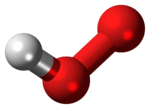Hydroperoxyl
 | |
| Names | |
|---|---|
Preferred IUPAC name Hydroperoxyl | |
Systematic IUPAC name Dioxidanyl | |
| Other names Peroxyl radical | |
| Identifiers | |
CAS Number |
|
3D model (JSmol) |
|
ChEBI |
|
ChemSpider |
|
Gmelin Reference | 506 |
PubChem CID |
|
InChI
| |
SMILES
| |
| Properties | |
Chemical formula | HO2 |
Molar mass | 33.01 g·mol−1 |
Acidity (pKa) | 4.88[1] |
Basicity (pKb) | 9.12 (basicity of superoxide ion) |
Conjugate base | Superoxide anion |
Except where otherwise noted, data are given for materials in their standard state (at 25 °C [77 °F], 100 kPa). | |
Infobox references | |
The hydroperoxyl radical, also known as the perhydroxyl radical, is the protonated form of superoxide with the chemical formula HO2.
Contents
1 Reactivity
2 Reactive oxygen species
3 Importance for atmospheric chemistry
4 Nomenclature
5 References
Reactivity
The superoxide anion, O−
2, and the hydroperoxyl radical exist in equilibrium in aqueous solution:
O−
2 + H2O ⇌ HO2 + OH−
The protonation/deprotonation equilibrium exhibits a pKa of 4.88;[1] consequently, about 0.3% of any superoxide present in the cytosol of a typical cell is in the protonated form.
Reactive oxygen species
Together with its conjugate base superoxide, hydroperoxyl is an important reactive oxygen species. Unlike O−
2, which has reducing properties, HO2 can act as an oxidant in a number of biologically important reactions, such as the abstraction of hydrogen atoms from tocopherol and polyunstaturated fatty acids in the lipid bilayer. As such, it may be an important initiator of lipid peroxidation.
Importance for atmospheric chemistry
Gaseous hydroperoxyl is involved in reaction cycles that destroy stratospheric ozone. It is also present in the troposphere, where it is essentially a byproduct of the oxidation of carbon monoxide and of hydrocarbons by the hydroxyl radical.[2]
Because dielectric constant has a strong effect on pKa, and the dielectric constant of air is quite low, superoxide produced (photochemically) in the atmosphere is almost exclusively present as HO2. As HO2 is quite reactive, it acts as a "cleanser" of the atmosphere by degrading certain organic pollutants. As such, the chemistry of HO2 is of considerable geochemical importance.
Nomenclature
Hydroperoxyl is also known as superoxide.[3]
References
^ ab "Reactivity of HO2/O−
2 Radicals in Aqueous Solution". J. Phys. Chem. Ref. Data. 14 (4): 1041–1091. 1985..mw-parser-output cite.citation{font-style:inherit}.mw-parser-output q{quotes:"""""""'""'"}.mw-parser-output code.cs1-code{color:inherit;background:inherit;border:inherit;padding:inherit}.mw-parser-output .cs1-lock-free a{background:url("//upload.wikimedia.org/wikipedia/commons/thumb/6/65/Lock-green.svg/9px-Lock-green.svg.png")no-repeat;background-position:right .1em center}.mw-parser-output .cs1-lock-limited a,.mw-parser-output .cs1-lock-registration a{background:url("//upload.wikimedia.org/wikipedia/commons/thumb/d/d6/Lock-gray-alt-2.svg/9px-Lock-gray-alt-2.svg.png")no-repeat;background-position:right .1em center}.mw-parser-output .cs1-lock-subscription a{background:url("//upload.wikimedia.org/wikipedia/commons/thumb/a/aa/Lock-red-alt-2.svg/9px-Lock-red-alt-2.svg.png")no-repeat;background-position:right .1em center}.mw-parser-output .cs1-subscription,.mw-parser-output .cs1-registration{color:#555}.mw-parser-output .cs1-subscription span,.mw-parser-output .cs1-registration span{border-bottom:1px dotted;cursor:help}.mw-parser-output .cs1-hidden-error{display:none;font-size:100%}.mw-parser-output .cs1-visible-error{font-size:100%}.mw-parser-output .cs1-subscription,.mw-parser-output .cs1-registration,.mw-parser-output .cs1-format{font-size:95%}.mw-parser-output .cs1-kern-left,.mw-parser-output .cs1-kern-wl-left{padding-left:0.2em}.mw-parser-output .cs1-kern-right,.mw-parser-output .cs1-kern-wl-right{padding-right:0.2em}
^ "Hydroperoxyl radical". Glossary of Meteorology. American Meteorological Society. 25 April 2012. Retrieved 22 August 2013.
^ IUPAC: Red Book. p. 73 and 320.







